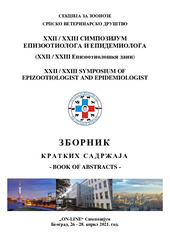Приказ основних података о документу
Značaj molekularnih metoda u dijagnostici krpeljima prenosivih bolesti pasa - molekularna potvrda monocitne erlihoze pasa uzrokovane sa Ehrlichia canis
Importance of molecular methods in diagnostic of canine tick-borne diseases - molecular confirmation of canine monocytic ehrlichiosis caused by Ehrlichia canis
| dc.creator | Sukara, Ratko | |
| dc.creator | Andrić, Nenad | |
| dc.creator | Francuski Andrić, Jelena | |
| dc.creator | Tomanović, Snežana | |
| dc.date.accessioned | 2024-01-31T10:50:55Z | |
| dc.date.available | 2024-01-31T10:50:55Z | |
| dc.date.issued | 2021 | |
| dc.identifier.isbn | 978-86-83115-41-9 | |
| dc.identifier.uri | https://vet-erinar.vet.bg.ac.rs/handle/123456789/3603 | |
| dc.description.abstract | Mоноцитна ерлихиоза паса (МЕП) једна је од важнијих крпељима преносивих болести у јужној Европи. Главни узрочник је грам негативнa бактерије Ehrlichia canis, која у цитоплазми инфицираних леукоцита формира структуре зване моруле. У Европи се смеђи псећи крпељ - Rhipicephalus sanguineus сматра главним вектором. Различите фазе и вишеструке клиничке манифестације МЕП, као и потенцијалне коинфекције другим патогенима који се преносе крпељима (Babesia spp., Hepatozoon canis, Anaplasma phagocytophilum, A. platys) компликују постављање поуздане дијагнозе. Иако су хематолошке, серолошке и цитолошке дијагностичке технике од велике важности за МЕП, молекуларне методе (PCR, qPCR) су често неопходне за коначну дијагнозу. Тромесечно власничко женско штене ротвајлера из околине Београда без историје путовања у ендемскa подручјa, доведено је на клинику Ветеринарског факултета у Београду због летаргије, анорексије и генерализоване лифаденопатије. Девет дана пре довођења на преглед извађен је крпељ. Хематолошке анализе потврдиле су присуство нормоцитно нормохромне анемије, лимфоцитозе и тромбоцитопеније. На крвном размазу и размазу издвојених леукоцита (buffy coat) уочено је присуство гранулираних лимфоцита. Брзи антитело тест (Bionote, Korea) указао на изложеност Е. canis. Да би се потврдила дијагноза, изолована је укупна ДНК из ЕДТА крви и изведен је конвенционални PCR праћен секвенцирањем. Упоређивањем добијене секвенце са секвенцама депонованим у GenBank®, потврђено је присуство E. canis. Иако серолошке методе могу указивати на изложеност E. canis (индиректна имунофлуоресценција- ИФА, ЕЛИСА тест), PCR са великом специфичности и осетљивости је од суштинског значаја за детекцију ДНК E. canis и овај налаз указује на активну инфекцију. Поред тога, детекција ДНК је могућа и пре сероконверзије. Недостатак серолошких испитивања такође је и појава унакрсне реактивности E. canis са другим врстама из породице Anaplasmacataceae (E. chaffeensis, E. ewingii, A. phagocytophilum). Описани случај је прва молекуларна потврда МЕП и присуства E.canis у Србији и указује на важност примене молекуларних метода у циљу успостављања поуздане дијагнозе код крпељима преносивих болести паса. | sr |
| dc.description.abstract | Canine monocytic ehrlichiosis (CME) is one of the major tick-borne diseases in southern Europe. The main causative agent is gram-negative bacteria Ehrlichia canis, which in the cytoplasm of infected leukocytes forming structures called morulae. In Europe, brown dog tick Rhipicephalus sanguineus, is considered as the main vector. Different phases and multiple clinical manifestations of CME, as well as potential coinfections with other tick-borne pathogens (Babesia spp., Hepatozoon canis, Anaplasma phagocytophilum, A. platys) complicate reliable diagnosis. Even haematological, serological and cytological diagnostic techniques are of great importance for CME, molecular methods (PCR, qPCR) are often necessary for a definitive diagnosis. Proprietary, three months old female Rottweiler puppy from the vicinity of Belgrade city without a history of travel to the endemic area was brought to the clinic of the Faculty of Veterinary Medicine in Belgrade due to the presence of lethargy, anorexia and generalized lymphadenopathy. Nine days before presentation tick was removed from the dog. Haematological analyses showed the presence of normocytic normochromic anemia, lymphocytosis and thrombocytopenia. On blood and buffy coat smears granular lymphocytes were noted. Antibody SNAP test (Bionote, Korea) indicated exposure to E. canis. To confirm the diagnosis, total DNA was extracted from EDTA blood and conventional PCR followed by sequencing was performed. By comparing the obtained sequence with the sequences deposited in GenBank®, the presence of E. canis was confirmed. Although serological methods may indicate exposure to E. canis (indirect fluorescent antibody- IFA, enzyme-linked immunosorbent assays- ELISA), PCR with high specificity and sensitivity is essential to detect DNK of E. canis indicating active infection. Also, DNA detection is possible before seroconversion. The ambiguity of serological assays may be also the appearance of cross-reactivity among E. canis and other species of the Anaplasmacataceae family (E. chaffeensis, E. ewingii, A. phagocytophilum). The described case was the first molecular confirmation of CME and E. canis in Serbia, pointing to the importance of molecular methods in reliable diagnosis. | sr |
| dc.language.iso | sr | sr |
| dc.language.iso | en | sr |
| dc.publisher | Beograd : Srpsko veterinarsko društvo, Sekcija za zoonoze | sr |
| dc.relation | info:eu-repo/grantAgreement/MESTD/inst-2020/200015/RS// | sr |
| dc.rights | openAccess | sr |
| dc.rights.uri | https://creativecommons.org/licenses/by/4.0/ | |
| dc.source | XXII/XXIII Simpozijum epizootiologa i epidemiologa, Beograd, 26 - 28. april, 2021 | sr |
| dc.subject | Ehrlichia canis | sr |
| dc.subject | молекуларна дијагностика | sr |
| dc.subject | Србија | sr |
| dc.subject | крпељима преносиве болести паса | sr |
| dc.subject | Ehrlichia canis | sr |
| dc.subject | molecular diagnostic | sr |
| dc.subject | Serbia | sr |
| dc.subject | canine tick-borne diseases | sr |
| dc.title | Značaj molekularnih metoda u dijagnostici krpeljima prenosivih bolesti pasa - molekularna potvrda monocitne erlihoze pasa uzrokovane sa Ehrlichia canis | sr |
| dc.title | Importance of molecular methods in diagnostic of canine tick-borne diseases - molecular confirmation of canine monocytic ehrlichiosis caused by Ehrlichia canis | sr |
| dc.type | conferenceObject | sr |
| dc.rights.license | BY | sr |
| dc.citation.spage | 178 | |
| dc.citation.epage | 179 | |
| dc.description.other | Zbornik kratkih sadržaja | sr |
| dc.identifier.fulltext | http://veterinar.vet.bg.ac.rs/bitstream/id/10784/bitstream_10784.pdf | |
| dc.identifier.rcub | https://hdl.handle.net/21.15107/rcub_veterinar_3603 | |
| dc.type.version | publishedVersion | sr |

